FishDuck.com has gone off an active writing schedule, but the site will remain up so that all the prior articles can be found on the web. We are also open to guest articles from writers such as our beloved Grizzled Ol’ Coach, Mike Morris. He is sharing some of his knowledge about the 4-3 defense and how the Oregon personnel could fit into it. Do check in from time-to-time as we will have more analysis articles about the 4-3. Charles Fischer
Well, it seems we now have a whole lot of divided Duck fans: for and against the Brady Hoke hiring and for and against the switch from a 3-4 to a 4-3 defensive front. I’m definitely not going to go negative on the selection of Hoke; it is what it is. It is time to move on, to reunite and see if we can get realistically optimistic about the NEW Duck defense.
First, I have to state my favorite axiom — the one I go to whenever there’s a schematic argument — “It’s not WHAT you do, but HOW you do it.” Sorry, to those of you looking for a magical cure, but whether it is the 3-4 or the 4-3 … there’s no BEST defensive system and no infallible defensive coordinator, whose schemes confound offensive players and renders all their plays useless. Name the system and/or the coach, and you’ll find several examples of them getting shredded.
HOWEVER, there can be a BETTER defensive system and a better way to teach that system and utilize the available talent. “Significant improvement” — that’s all you’re asking for, right? [Well, besides winning every game.]
SO FAR, SO GOOD:
I was worried that Mark Helfrich was bringing in Brady to coach inside linebackers (ILBs) in a 3-4 defense. My bad; Mark is much smarter than that. The 4-3 had to come with Brady.
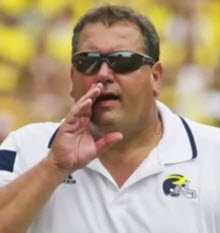
Brady Hoke
- The 4-3 defense is what Brady’s always coached, and against some real good offenses in some real big games. Experience — even/especially negative moments — can bring positive results/improvements. It’s called “learning.”
- Last year, Hoke significantly added to his knowledge by taking a nation-wide tour of learning about defense from other coaches. That constructive desire and energy [and possible accumulated wisdom] impresses me.
- Because it’s the 4-3, Don Pellum can coach all the LBs; he couldn’t do that in a 3-4.
- “It’s not what you know, it’s what you can TEACH.” (That is another of my favorite axioms.) A coach’s knowledge does him no good if his players can’t correctly execute the things he knows. Hoke is now freed up as a “walk-around” coordinator, helping the other defensive coaches teach his system.
- The new emphasis seems to be on keeping the defensive system simple and teaching it thoroughly.
I read an interview with Hoke in which he criticized what the Michigan defense had become, when he coached there. He said they’d gotten too complicated, too smart for their own good and gotten away from the “basics.” Many of us, including Mark Helfrich, thought that about the Oregon defense. Helfrich is even changing the Ducks’ vocabulary [“verbiage”] because it had become confusing. Hoke has never had to call defenses at such a rapid pace due to the no-huddle offenses, hence simplicity works best under fire. Helfrich says the Ducks will “start from scratch” at thoroughly teaching the basics.
A coach’s primary goal shouldn’t be to win games; it should be “to develop his players to the maximum of their potential.” A player can’t play to his max if he’s even slightly confused, and in 2015, we saw far too many mental mistakes by confused Duck defenders. That is unacceptable and had to change. Brady Hoke convinced Mark Helfrich that’s not going to happen on his watch, that he’s truly “detail-oriented.”
LET’S LOOK AT THE 4-3 DEFENSE:
The 4-3 is much easier to execute for the defensive line (DL) and ILBs than the 3-4, and the transition won’t be hard. The Ducks actually used a form of the 4-3, usually in passing situations, almost as much as their base 3-4.
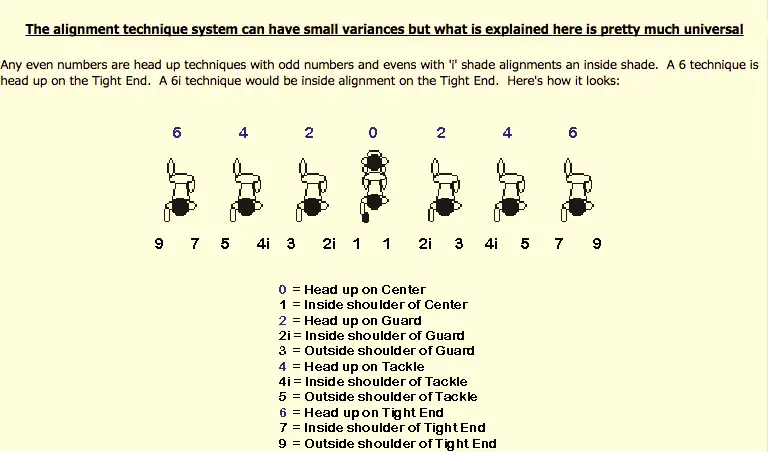
In the 3-4 defensive fronts Oregon most often used a “404”: [where the defensive ends played a 4-technique and the nose tackle a 0-technique], and the linemen used a very difficult 2-gap technique. (Note: If you’re not a coach, hang in there. I’m not going to go all-technical on you. FishDuck wants these articles written for non-coaches.)
All three defensive linemen had to attack an offensive blocker, “control” him, getting the proper arm’s-length leverage, find the ball, separate from the blocker and then go make the tackle, to either side of them. Thus the term, “2-gap” defense. That’s really hard, and requires long arms and a lot of strength.
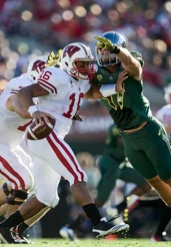
Kiko Alonso sacks Russell Wilson in the Rose Bowl.
The ILBs had to read “flow” of the backs, and then fill the appropriate gap: D-gap on flow to, and the A-gap on flow away. Great ILBs, such as Kiko Alonso and Michael Clay, could do this very well; not-so-great ILBs, not so well. Most of the time you saw a ball carrier going thru a huge hole was because an ILB didn’t properly fill that hole. Never has a team been more successful with worse ILB play than the last two Oregon teams!
But now, in the 4-3, each of the Ducks’ front 7 has only 1 gap to be responsible for. The defensive tackles (DTs) can more aggressively attack; they can now immediately penetrate the LOS. Also, because they don’t have to control the blocker, they don’t have to be as big and strong; thus they can be faster, and speed is a good thing.
Because they only have 1 gap to fill, the ILBs are less likely to be confused and more likely to attack quickly and aggressively. Did you notice Joe Walker’s improvement from his jr. to his sr. year? And yet he still had moments of confusion. So, hopefully, simplifying the gap responsibilities and necessary techniques will make Oregon a smarter, quicker-reacting, more aggressive defense.
SO WHO WILL DO WHAT?
DEFENSIVE TACKLES:
The defensive tackles in a 4-3 have to be able to execute the 1-technique [attack one side of the center, and be responsible for the A-gap] and 3-technique [attack the outside shoulder of an offensive guard, and be responsible for the B-gap]. The defense is called based on where the DTs align, and it should be a damn good, badass group. They’ll definitely prefer trying to wreak havoc in the offensive backfield to trying to control 300+ lb. offensive linemen.
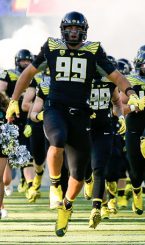
Canton Kaumatule
A possible [educated guess] depth chart of defensive tackles is:
Canton Kaumatule Austin Maloata
Rex Manu Drayton Carlberg
Gary Baker Jordan Kurahara
*Henry Mondeaux [if needed or in pass rush situations]
*TJ Daniel [as a pass rusher]
No freshmen yet [1-18], although I think Hunter Kampmoyer will grow into a DT. Our friends at Duck Territory reported on January 19th how Brady Hoke told a fan that his “biggest need by far was another huge DT.” At that time he was flying to Cincinnati to meet with one as Hoke and Helfrich would meet in Idaho the next day to huddle with another defensive tackle prospect.
DEFENSIVE ENDS:
Not only do 4-3 DTs not have to be as big and strong as 3-4 nose tackles, 4-3 defensive ends (DEs) who aren’t physical enough to play DE in a 3-4 can be very effective in a 4-3 if they have sufficient speed.
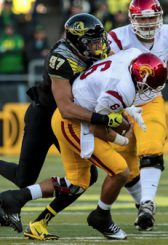
Jalen Jelks sacks Cody Kessler.
Jalen Jelks comes immediately to mind. Coach Ron Aikens raves about Jelks’ athletic, and pass rushing, ability, but Jalen’s built on the slender side. He’ll prosper as a 4-3 DE. RFR Gus Cumberlander will benefit in the same way.
Also Mondeaux and TJ Daniel can lose some now unnecessary weight and become faster, better outside pass rushers.
OLBs who are too big to play well in space are also 4-3 DE candidates such as Cody Carringer, and, maybe, Eddie Heard.
Because of all the no-huddle offenses and shifting that takes place, it’s a lot better if the DEs don’t have to switch sides. They play a wide-5-technique if there’s no TE, and either a 7 or 9 technique vs a TE.
Possible depth chart for 4-3 Defensive Ends:
Henry Mondeaux Jalen Jelks
TJ Daniel Gus Cumberlander
Eddie Heard Cody Carriger
Bryson Young: frosh Hunter Kampmoyer: frosh
*Torrodney Prevot [in pass rush situations]
*Justin Hollins [in pass rush situations]
In the future, the 4-3 DE will be the easiest position to recruit quality players to. High school studs, who’ve never played defense in space, or aren’t big enough to play DT are great candidates. You no longer have to convert them to 3-4 OLBs.
OUTSIDE LINEBACKER or “SAM”:
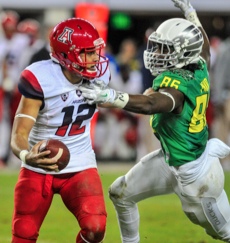
Torrodney Prevot
Prevot could bulk up and be a very good 4-3 DE, but he’s much more needed as an OLB. T-rod hasn’t been very good in space, but he’s had a lot of practice at it. He’s definitely a great athlete, and he’ll be a senior auditioning for the NFL. I’d also expect Prevot to often be used at DE, as a pass rusher, in nickel/passing situations. What a difference-maker T-rod could be.
A great addition to this year’s Ducks could be RSO Hollins [like Prevot, a highly recruited high school DE from Texas], who missed all of last year with an injury. Hollins showed a lot of potential as a freshman and is a really fast 6’6″ guy who tackles well and can play in space. Justin could also be used as a DE in passing situations.
Also, Johnny Ragin seems better suited to be an OLB. Last year Ragin played quite a bit as an inside linebacker (ILB) in passing situations, but he doesn’t seem physical enough to be an every-down ILB.
JC transfer Paris Bostick never found a position last year. Too small to be an ILB and not ready to play safety in the Pac-12. Maybe?
Freshman walk-on Kaulana Apelu excelled on special teams, and got raves for his speed and toughness.
Speaking of tough, the notorious Fotu Leiato, famous for his ability to viciously tackle, might find a home as a 4-3 OLB, instead of a safety. Finally, true freshmen Lamar Winston, Eric Briscoe, and Troy Dye appear to be starting out as OLBs.
INSIDE LINEBACKERS/MIDDLE LINEBACKERS:
Projecting depth charts for those other positions weren’t that hard, but ILB? Damn.
The 4-3 scheme will help them somewhat because their gap responsibilities are more clearly defined. But the ILBs still have to be damn good football players, who can read offensive sets and plays correctly, and tackle really well against very talented players in space if the Ducks are going to be real good on defense in 2016.
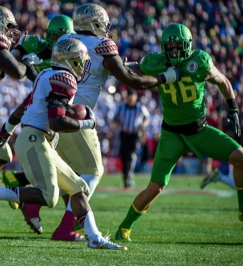
Danny Mattingly
To show how skeptical I am about the Ducks’ ILBs, my projected starters, as of January 18, have never played even one play of college football. AJ Hotchkins and Jonah Moi were teammates at Riverside CC and (Moi redshirted last year as an OLB) it’s strictly an educated hunch on my part. But big-time help is needed big-time, and those two guys have the bodies, the reputations, and the [“Kiko-like”] highlight films to make me think, maybe …
Of course, a big part of my optimism about Hotchkins and Moi is due to my pessimism about the other ILBs. Danny Mattingly has the physical tools, but he hasn’t shown he can do the job yet. He was worse than Rodney Hardrick, and that’s kinda amazing. And what does that say about Jimmie Swain? Looks great in warm-ups and in interviews, but he wasn’t good enough to get any significant playing time?
I’ve already mentioned Ragin, who I don’t think is physical enough to be a major contributor at ILB. Freshman Darrian Franklin will be here for spring practice, but … he IS a true freshman. Heard has the body, but not the instincts, to be converted.
I don’t understand why the top two high school ILBs in the nation aren’t going to Oregon next year? What a missed opportunity for them to play right away … Maybe Hoke will pull off a major surprise?
SECONDARY:
The DBs should be unaffected by the changes in the front 7, except that their jobs will be a lot easier if the front 7 is effectively doing their jobs. It’s easy to get a 5th DB/”nickel back” in as a replacement for the OLB. I think the secondary, because they had so many painful experiences last year, will be very strong in 2016.
PHILOSOPHY:
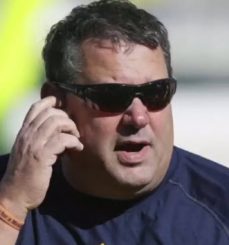
Brady Hoke
I’m hoping Brady Hoke isn’t a “bend-but-don’t-break” guy. Brady told a fan recently (from Duck Territory) that he wants to use the speed he has on defense to more aggressively attack opposing offenses. Yeah! Like most of you, I want the defense to ATTACK!
I’m well aware of the possible consequences [think Arizona St.], but attacking doesn’t necessarily mean blitzing all the time. The strived-for goal of the Oregon 4-3 defense should be to stuff the run and consistently pressure the passer without over-doing the blitzing. The less time Duck opponents’ defenders get to rest, the better it is for Oregon’s offense.
Come on, Brady! Teach ’em how to effectively attack, and maybe you’ll have such an enjoyable time you won’t want to go back to being a head coach.
Mike Morris
Top Screenshot from OregonLive Video
Related Articles:
Seven Offensive Coordinator Candidates for the Oregon Ducks
Five Candidates to Replace OC Marcus Arroyo
Coach Jim Mastro: The Perception, and the Truth
Has Oregon Turned the Corner on Offense?
Ducks, Taggart Punish Beavers; Earn Bowling Trip
Textbook Defense, Herbert's Return Energize Duck Victory; Civil War Next
Coach Mike Morris spent 30 years coaching at seven different high schools throughout Southern California. He coached many players who went on to Pac-12 programs including Oregon, such as Saladin McCullough. He is a writer, Football analyst and a good friend of the Principal of the site.

